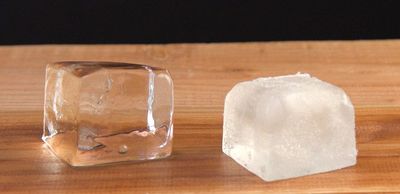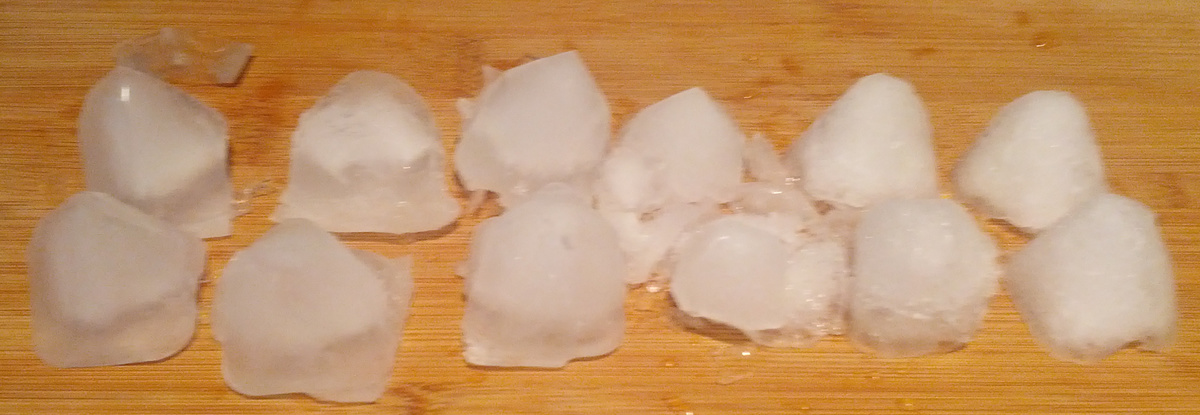Fancy ice cubes
Once I went to a fancy restaurant where the ice cubes were clear like a glass of water. When I make them at home, they're opaque and I can't see through them.

The iced drinks I make are never as pretty as the ones at the restaurant. Which of the following approaches might make my ice cubes more clear?
This section requires Javascript.
You are seeing this because something didn't load right. We suggest you, (a) try
refreshing the page, (b) enabling javascript if it is disabled on your browser and,
finally, (c)
loading the
non-javascript version of this page
. We're sorry about the hassle.
11 solutions
It also means the bacteria gets out of the water.
Log in to reply
Wouldn’t the bacteria still be there? Just dead? Also I’ve heard that when ice sculptures make there blocks of ice they vibrate the water during the freezing process to achieve clear blocks, is this true?
Log in to reply
Kimmel is right
Log in to reply
@Walter Neilsen-Steinhardt – That's exactly what I meant, the bacteria contains chemicals which make the ice appear very translucent~opaque. I only meant that these chemicals get out. Sorry for the inconvenience.
Yes it is.
There was a huge video on this somewhere, especially how ice sculptures make their ice. A machine cleans it, filters it, keeps it in constant circulation as it freezes. Lastly the machine freezes it from one face of the block to the other, to let all the bubbles evacuate.
Log in to reply
Half-century ago Sci.Am. called that 'last' note "Traveling Phase Purification", a technique that has also been used for centuries in freezing weather to purify brine for drinking, by pouring out the center contaminate concentrate, before allowing the purified ice to melt for drinking water. This apparently depends on a phenomenon of solidification phase surface exclusion of molecules that "don't fit'.
I wonder if castaways adrift at sea have ever used that technique to extend their survival in freezing weather.
This technique was also used in some labs to purify iron almost to the softness of lead, by passing a molten phase along the length of an iron rod, to concentrate the contaminants at one end, to be removed.
Boiling the water will tend to de-gas it, but boiling also tends to agitate the water, leading to gas absorption: it is a tricky business. I just wash off the cubes from the tray and get pretty clear ice.
Boiling water doesn’t tend to make too much of a difference in the real world, I was luck enough to attend a lecture with Camper English on the subject of clear ice http://www.alcademics.com/ice/
removing the air by boiling, in your opinion, will also remove impurities? Or is it the minerals in the tap water that make the ice cloudy? Restaurants that have ice-making machines also have resin filters to remove minerals
But how his ice turned opaque when he reached home?
Log in to reply
Because he didn't boil the water.
Log in to reply
Boiling water kills the bacteria inside it, making it very clear
After boiling the water ,water gets almost free from dissolved air,as solubility of gases decreases with temperature.which results in transparency of ice cube ,since there remains almost no impurity to make it opaque.
Very correct, Arjun!
Exactly! Unfortunately I didn't think of the fact that gases become less soluble with temperature.
The ice become opaque because of air trapped in the water,which gets stuck when it freezes. So by boiling water will remove air stuck in water and.now when you will freeze water it will be transparent.
Rather than guess, I did the experiment. None of these make any real difference. You can see little bubbles in the ice made from carbonated water. But that's about it. See if you can tell the difference. There are 4 cubes of each from left to right. Which is which?

didn't have an ice cube tray?
This answer "boil the water" actually upset me because I've never seen it work. I was hoping the answer was something else... Maybe you need to boil it a few times...
Interesting fact, pure H2O will not freeze until it has an impurity or bubble for the crystal structures to start forming. Then once they start forming it's a chain reaction until it's all frozen.
Did you put the tray in the freezer while the water was still hot?
This doesn't actually work very well. A better solution is to boil it first, then put it in a cooler with the lid removed and freeze. This is because it will freeze only on one side (the exposed top), pushing any impurities in the water toward the bottom. Before it has a chance to freeze all the way through you remove the ice and discard the dirty water at the bottom. Clear ice. This process is similar to why frozen pond ice is clear. Just boiling it will give you clearer ice but not perfectly clear ice.
Boiling will help, but almost all clear ice in bars is manufactured using directional freezing: http://www.alcademics.com/2016/04/what-is-directional-freezing.html
Some of the idea I think for boiling water is that solubility of gasses in the air decreases as temperature increase (google solubility of gasses vs temperature) so therefore gasses are released from the water that is to become ice. However this doesn’t apply to dissolved impurities such as salt. As water freezes the salts or other dissolved impurities will be slowly “pushed” out and they form what looks like a “cloud” within the centre of the ice cube, which is usually the last part to freeze. This is called brine rejection (https://en.m.wikipedia.org/wiki/Brine_rejection). In the Wikipedia case the salt sinks, in our ice cube case it and other impurities get “pushed” to the centre as the water freezes. As another writer wrote, directional freezing can move this cloudy part to, for example, the bottom part of the ice and make the top clear. Include only the top and we get clear ice from a machine or lake!
So boiling water may make it clearer, but if you have lots impurities in your water that are not dissolved gasses, you will still get “cloudy “ ice.
Clear ice refers to a solid precipitation which forms when air temperature is between 0 °C (32 °F) and there are supercooled, relatively large drops of water (from freezing fog) . A rapid accretion and a slow dissipation of latent heat of fusion favor the formation of a transparent ice coating, without air or other impurities.
A similar phenomenon occurs when freezing rain or drizzle hit a surface and is called glaze.
Clear ice, when formed on the ground, is often called black ice, and can be extremely hazardous.
Clear ice is denser and more homogeneous than hard rime; like rime, however, clear ice accumulates on branches and overhead lines, where it is particularly dangerous due to its relative high density.
As there is dissolved air in normal water so when we freeze it this forms a translucent or whitish ICS cube After heating or boiling air gets out of water so when we heat it forms a transparent ice
Hot water releases more carbon dioxide that had been saved inside the water to the air, causing less carbon dioxide to be inside the water. Hence, the ice cubes are clearer
B o i l e d w a t e r
Boiling water causes the air that is trapped between the water molecules to come out of the water (by thermal agitation); as the impurities in water are what causes the ice to be white, if we remove the air this way, it should be clear.